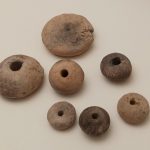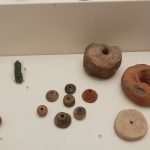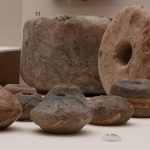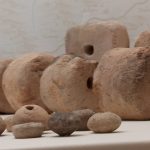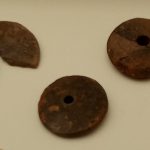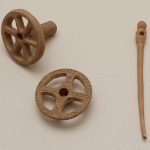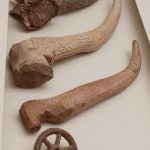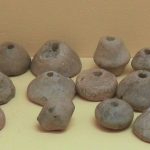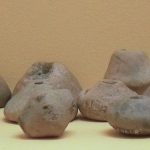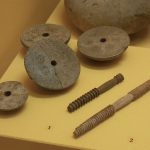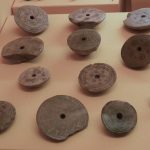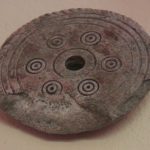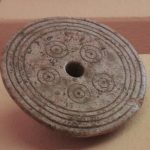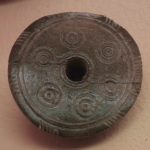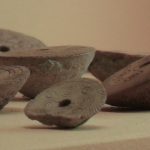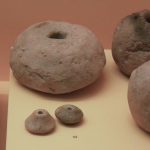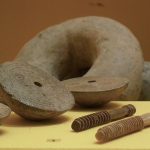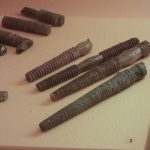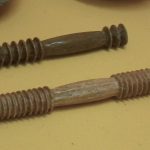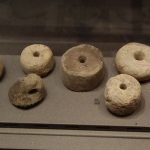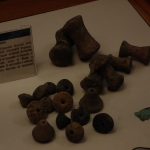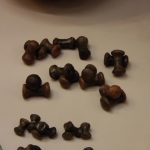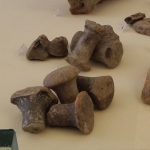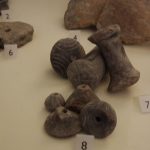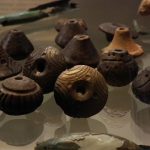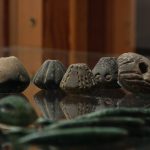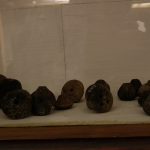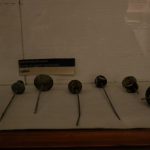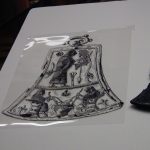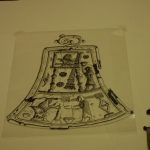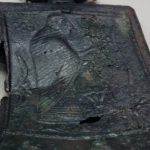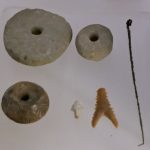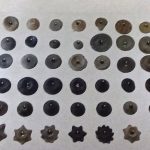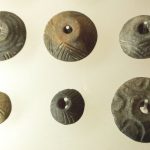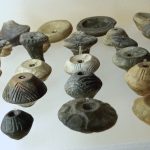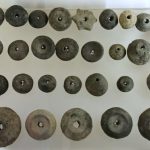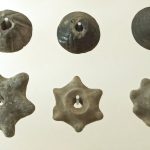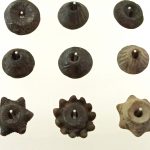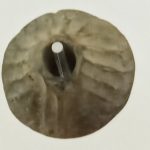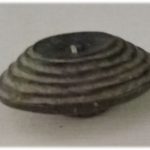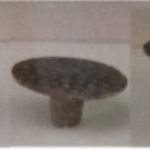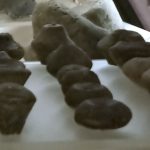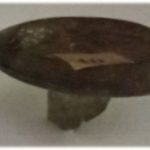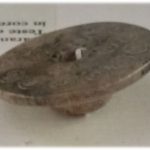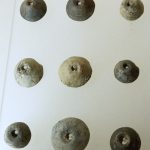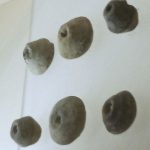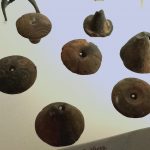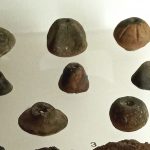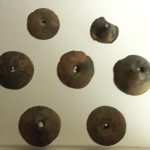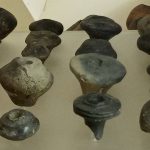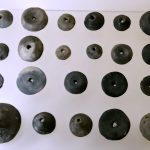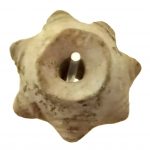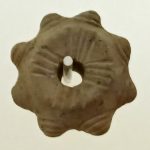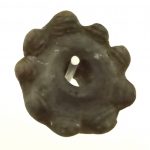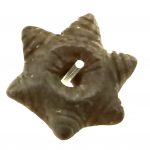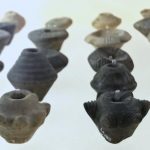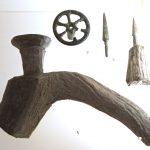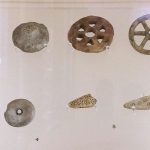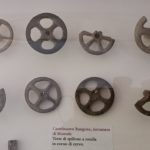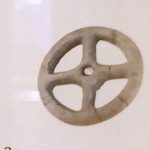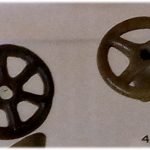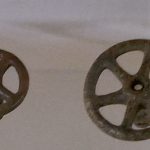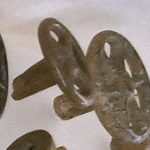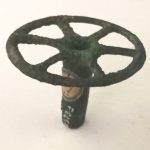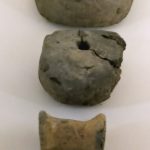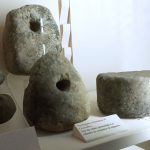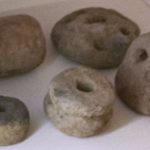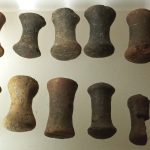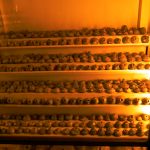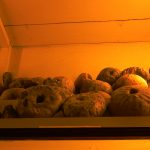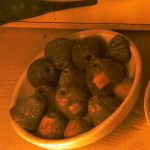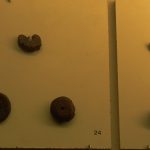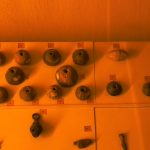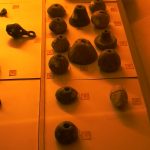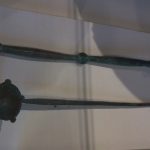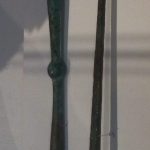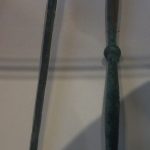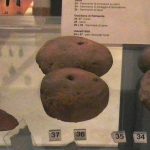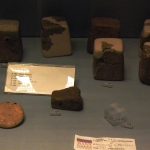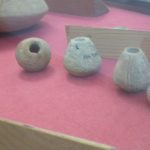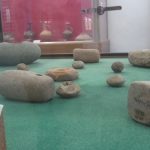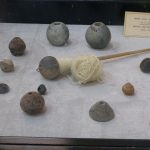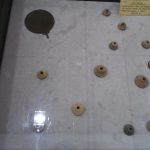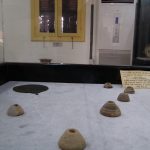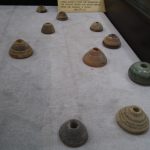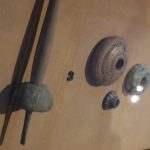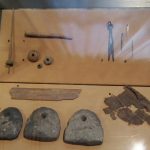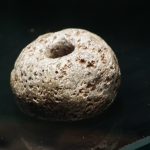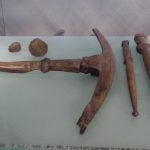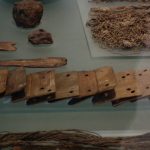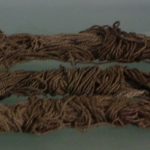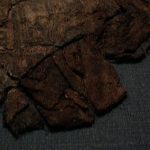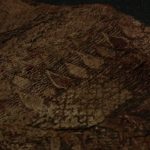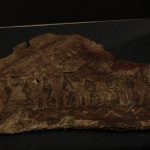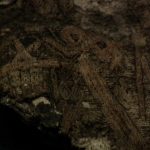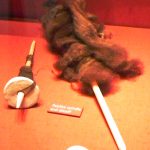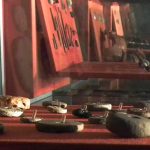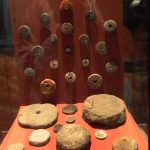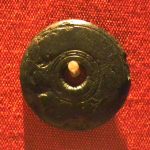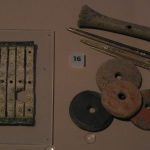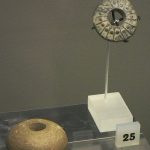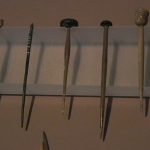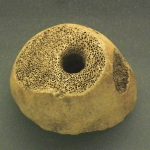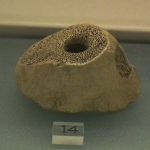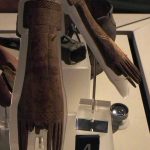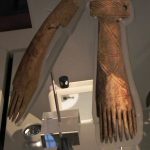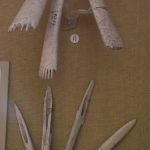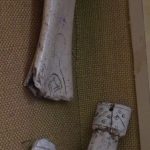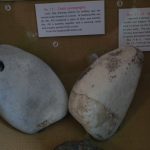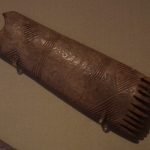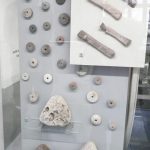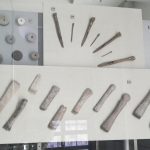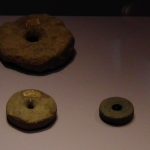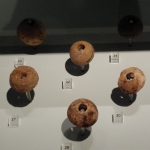The field of archaeological textiles is a difficult specialty since most of the material deteriorates rapidly. Because they are so ephemeral, it is a rare occasion when prehistoric textiles are recovered. However, we do have many of the tools used for making textiles that include spindle whorls, loom weights, combs, and other objects associated with the craft. This page catalogues textile tools that I have seen in museums ranging from early Neolithic spindle whorls to Viking and Medieval assemblages.
Please note that many of these photos are taken from outside glass cases and I am unable to provide measurements and weights. However, I will do my best to provide as much information about the context as possible. If you need further information, please check the museum’s website. Many now include online catalogues of their collections. It is also worthwhile to contact the museum directly with any questions you may have.
Some resources for those of you who are interested in historical and ancient textiles include the European Textile Forum whose mission is “…to give academics and craftspeople working with historical textile techniques a place and opportunity to meet with each other. This is the perfect surrounding and the perfect place to solve technical questions regarding your textile and to get input from others working on similar pieces – both on the academic and on the craft side.”
At the end of the page there is a brief list of books and articles about ancient textiles.
Please click on the thumbnails below to see the larger images.
Italy
Musei di Palazzo Farnese Piacenza
The museum in Piacenza is a beautiful museum housed in the castle. When I visited the Etruscan section was being renovated, and I hope to return when that is opened. The prehistoric galleries are arranged chronologically and then by region and excavation. It is interesting to note both the similarities and the differences in whorls to those found farther east in Reggio Emilia, Modena, and Bologna. The star shaped whorls are less common, but there are more flat, discoid whorls.
Museo Archeologico Nazionale di Fratta Polesine
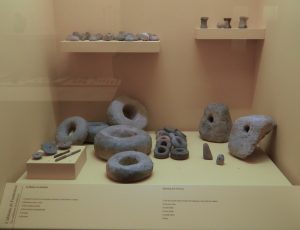
Fratta Polesine is the site of Frattesina, one of the earliest sites where glass was made in Europe. The excavations there revealed that it was a center for all kinds of craft activity, in addition to its famous glass there were ceramics, metalworking in bronze, lead, and gold, amber carving, ivory work, even ostrich eggs. Frattesina was a focus for trade around the world.
The exhibits cover the period from the Middle Bronze Age (14th-13th Century BC) to the Late Bronze Age/Initial Iron Age (11th-9th Century BC) in the region around Rovigo that includes Fratta Polesina, Gavello, Villamazana, and other sites.
The museum is in an out of the way place, but is worth the trip. The exhibits are modern displays that are well laid out with explanations in Italian and English. The textile tools here are made from a variety of materials including ceramic, antler, bone and ivory. The loom weights also come in a wide range of sizes.
Ceramic spindle whorls
The ceramic spindle whorls are rather plain and conical in contrast to whorls made in other media.
Antler, Bone, and Ivory Spindle Whorls
Weaving weights
Carved Sticks
There are a number of finely carved sticks that are found with textile tools, although there is no explanation for them. They are also found in burials.
Bologna Museum of Archaeology
I took some photos of textile tools while on a trip to the Museum of Archaeology in Bologna in 2017. The cases were nicely organised by context. That is, rather than group all the spindle whorls together in one case and all the beads together in another case, the objects were grouped according to where they were found. For example, if they were found in a burial, all the grave goods were displayed together. All the beads, spindle whorls, and other objects were on the same shelf with a card explaining the context and how the objects relate to each other. I have undone this a bit because the focus here is on textile tools. However, I will provide as much information as possible so that you will be able to do further research if you wish.
Spindle Whorls and Weaving Weights
Bobbins (Rocchetti)
Spindle whorls and Spindles
Representations of the Textile Industry
This object, a Tintinnabulo, described as a ritual pendent was part of a lavish burial in Tomb 5 of dell’Arsenale Militare (700-675 BC, Villanovan III). It depicts the steps in wool processing. The drawings show the engravings that are on the front and reverse of the tintinnabulo. More about the tintinnabulo and the burial can be found here.
Civic Museum of Archaeology and Ethnology, Modena
Modena is located in north-central Italy in the middle of the Po River Valley. The region is close to sea-level and bordered by the Alps to the north and the Apennines to the south. The Bronze Age settlements of the Terramare (Earth-sea) people were built up from the marshy lands and houses were built on stilts. The excavations of the region have yielded hundreds of spindle whorls and some beautiful bronze drop spindles. There is a recreation of a Terramara village, the Terramare in Montale, just to the south of Modena. I’ve also written about a day I spent there and included some photos of the reproductions of the textile tools.
Unlike museums in the US and UK, Italian museums tend to put everything on exhibit. Some unique ojects will be displayed on their own, but often trays of a hundred spindle whorls will be packed together in a display. While that makes it difficult to see individual whorls, it does give an idea of how many there were in use during a given period.
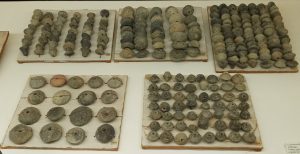
Middle to Late Bronze Age ceramic spindle whorls
The Terramare culture produced a wide variety of spindle whorl shapes, ranging from simple rondels to ones with points extending that look like stars. Some have extensions that create a shaft that extends along the spindle. Almost all of them are decorated in some way.
Star-shaped spindle whorls
The star-shaped whorls seem to be unique to this area and period. It might be a local tradition or even the work of an individual or family who produced these. I have made reproductions of them and they have a fascinating animated effect. At rest they look like stars, or at least something that has individual lobes or points. However, when spinning they appear to turn into circular whorls with concentric bands.
Antler pin heads and whorls
While described as spoked wheels and heads of pins, these also resemble spindle whorls, and certainly could be used in that way.
Bronze wheels
The spoked wheels cast in bronze closely resemble those carved from antler. These are also listed as pin heads, but could also serve as spindle whorls.
Bronze distaff?
I am fascinated by the bronze textile tools found here and in Reggio Emilia. The card in the case describes it as a conocchia, a distaff. However it would seem awkward to use as a distaff, and I always thought of these as drop spindles. Given that they are hollow, the weight would not be excessive. I would like to try making one for myself some day and try it out.
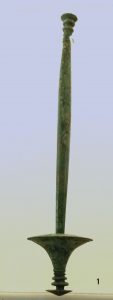
Loom weights and bobbins
All the loom weights represented here are made of ceramic material.
Civic Museums of Reggio Emilia
Reggio Emilia is a small city to the northwest of Modena, along the Via Emilia heading towards Milan. Like Modena the exhibits are chronological and just about everything is on display. It’s interesting to note the similarities and differences between the textile tools given how close Bologna, Modena, and Reggio Emilia are.
National Archaeological Museum in Naples
Museum Website (in Italian, the English version doesn’t appear to be working)
When I visited the museum in 2016 the Prehistoric wing was in the process of being remodelled and there were only a few textile tools on exhibit.
North Cyprus
Morphou Archaeology and Nature Museum, Güzelyurt
This is a small museum, but with great treasures. It’s definitely worth a visit if you’re in North Cyprus. There are only a few textile tools. The Middle Bronze Age I spindle whorls date from 1850-1800 BC. The bottom two photos are of loom weights, spindle whorls, and stone grinders that date to the Late Bronze Age, 1600 BC.
Bellapais Abbey and Museum, Girne
The museum is housed in a ruined monastery and is another small museum filled with treasures.
Archaeological Museum of Iskele
Iskele’s museum is new, opened in 2018, and hosts beautiful displays of objects from the Early Neolithic through the Roman period. Objects are displayed in groups in front of murals depicting scenes appropriate to the period. The spindle whorls below date from the Neolithic (8800 – 3800 BC) and are made of stone and bone.
Ashmolean Museum (Oxford, UK)
The Ashmolean has a large collection of material from Cyprus, including these steatite (soapstone) spindle whorls from Nicosia.
Norway
Historical Museum, Oslo
Museum website (in English)
I visited Oslo in 2017 and had a tour of the Historical Museum. The objects are sorted by type rather than chronologically, so visitors unfamiliar with different materials will need to check the guidebooks. These tools are from around the 9th century AD.
The Viking Ship Museum
Museum website (in English)
The textiles and tools come from the Oseberg boat burial. The boat was built in AD 820 and was in use until AD 834 when it was used for the burial of two women. The burial includes two chests that contained textiles woven from linen and wool, tapestries, and textile tools including a swift, distaffs, weaving tablets, shears, and looms. Raw materials, such as bundles of unspun flax were also a part of the goods interred with the women.
England
Unlike Italian museums, the ones in the UK display only their finest examples with much of the collection in storage. The museums here are arranged by city, roughly from north to south. Many of the museums in the UK have catalogues on their websites that include dimensions and weights for all the objects.
Arbeia Roman Fort & Museum, South Shields
Since I last visited Arbeia part of the vicus (the civilian village connected to the fort) was excavated. I expect that they now have many more textile tools.




Segedunum Roman Fort, Baths & Museum, Wallsend
Like other Roman forts, Segedunum would have had a village, called a vicus, close by. This would be the place were craftspeople would be making the things that the army couldn’t supply for itself, including cloth and cord.
Hancock Museum, Newcastle
The newly remodeled Hancock Museum has beautiful displays of textile tools that go from the prehistoric up to the medieval.
Bede’s World, Jarrow
Bede’s World is an open-air museum where you can walk around and into typical buildings from the Anglo Saxon period (5th to the 11th century AD). It is based around the Monastery of St Peter and the Venerable Bede. The monks there would have been likely to spin cloth and weave textiles.
Museum of Archaeology, Durham
Formerly in the Old Fulling Mill above the river, the museum is now housed in the buildings next to the cathedral.
Wiltshire Museum, Devizes
This is a difficult museum to visit. Devizes can only be reached by bus or car, but it is definitely worth the effort. The small museum houses great collections that are often overshadowed by all the material they display from Stonehenge and the gold from the various Bronze Age barrow burials.
The Museum of Somerset, Taunton
The Meare Lake Villages near Taunton were a major craft manufacturing site during the Iron Age in Britain (800 BC – AD 100). The site had evidence of metalworking, glassworking, wood, antler, and bone carving, pottery, and more. There was evidence of textile manufacture and of the manufacture of textile tools. More bone combs were found there than in the rest of Britain combined. It would be interesting to find if anyone has done a study to see if other bone combs in Britain and neighbouring regions can be traced back to Meare or Somerset. The combs are distinctive and carved from whalebone, indicating that in addition to manufacturing tools, there must have been a brisk trade in raw materials.
Royal Albert Museum, Exeter
Northern Ireland
Ulster Museum, Belfast

|
Did you find the information on this page useful? Please consider supporting this site with a donation through PayPal. Even small amounts help keep this website up and running. Thanks! Giovanna |
Another brief plug here. I make reproductions of some of these ancient spindle whorls in ceramic, pewter, and bronze. They are available at my Etsy shop.
For more information about textiles in archaeology and history, I can recommend the books below. Click on the title for a direct link.
Elizabeth Wayland Barber Women’s Work: The First 20,000 Years – Women, Cloth, and Society in Early Times
Craft Specialization and Social Evolution: In Memory of V. Gordon Childe edited by Bernard Wailes
Marie-Louise Nosch, C. Gillis Ancient Textiles: Production, Crafts and Society
Fanfani, Giovanni, Mary Harlow, Marie Louise Nosch (Editors) Spinning Fates and the Song of the Loom: The Use of Textiles, Clothing and Cloth Production as Metaphor, Symbol and Narrative Device in Greek and Latin Literature
Lilli Fransen, Shelly Nordtorp-Madson, Anna Norgard, Else Ostergard Medieval Garments Reconstructed: Norse Clothing Patterns
A brief selection of articles and other resources:
Chittock, Helen 2014 Arts and Crafts in Iron Age Britain: Reconsidering the aesthetic effects of weaving combs. Oxford Journal Of Archaeology 33(3) 313–326
Gleba, Margarita 2012 From textiles to sheep: investigating wool fibre development in pre-Roman Italy using scanning electron microscopy (SEM). Journal of Archaeological Science 39 (2012) 3643e3661
Mårtensson, Linda, Marie-Louise Nosch, and Eva Andersson Strand 2009 Shape Of Things: Understanding a loom weight. Oxford Journal Of Archaeology 28(4) 373–398
Rast-Eicher, Antoinette, Lise Bender Jørgensen 2012 Sheep Wool in Bronze Age and Iron Age Europe. Journal of Archaeological Science 40
Shishlina, N.I., O.V. Orfinskaya And V.P. Golikov 2003 Bronze Age Textiles From The North Caucasus: New evidence of fourth millennium bc fibres and fabrics. Oxford Journal of Archaeology 22(4) 331–344
Standley, Eleanor R. 2106 Spinning Yarns: The Archaeological Evidence for Hand Spinning and its Social Implications, c ad 1200–1500. Medieval Archaeology, 60/2
Webb, Jennifer 2002 New Evidence for the Origins of Textile Production in Bronze Age Cyprus. Antiquity 76

